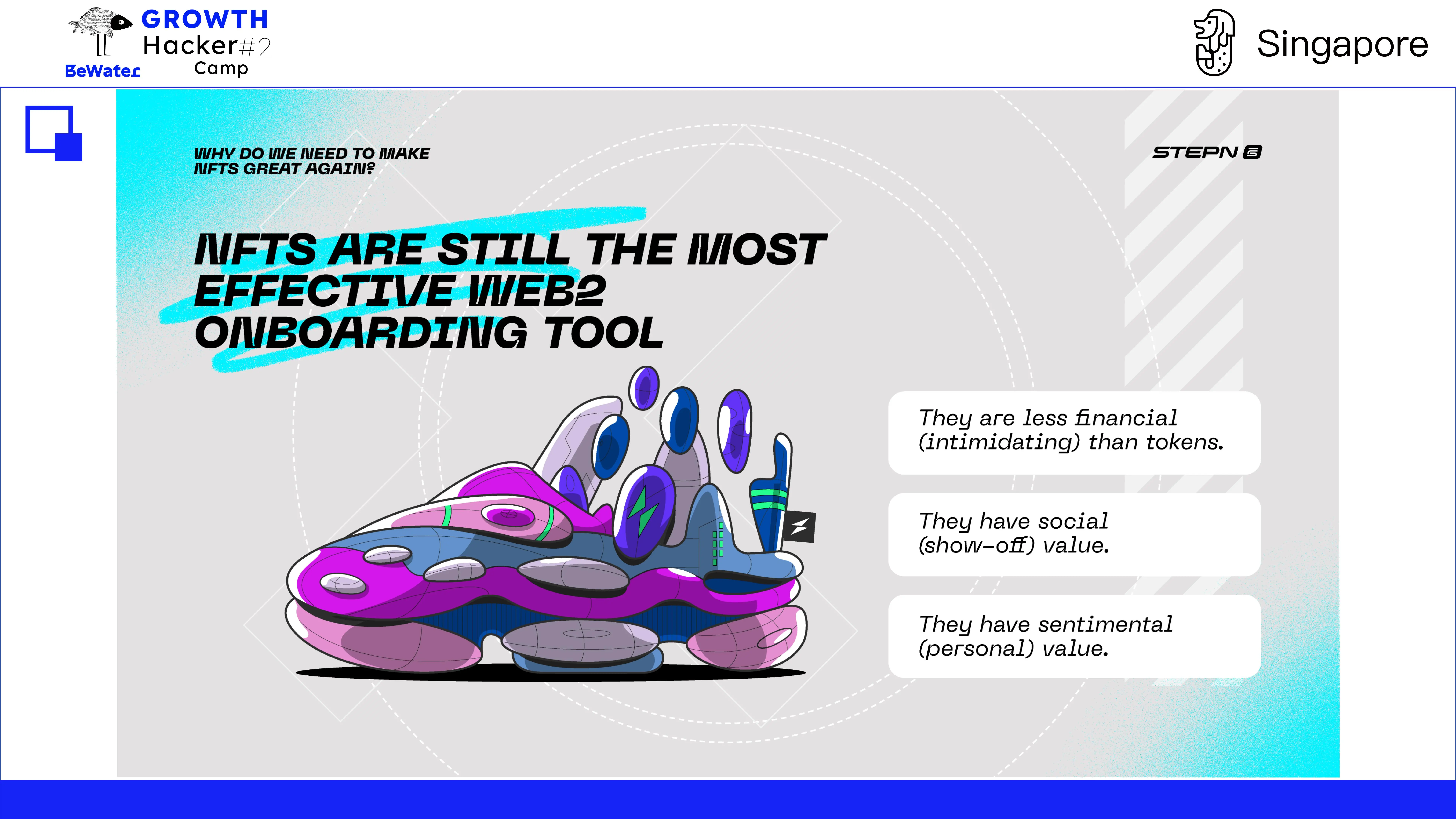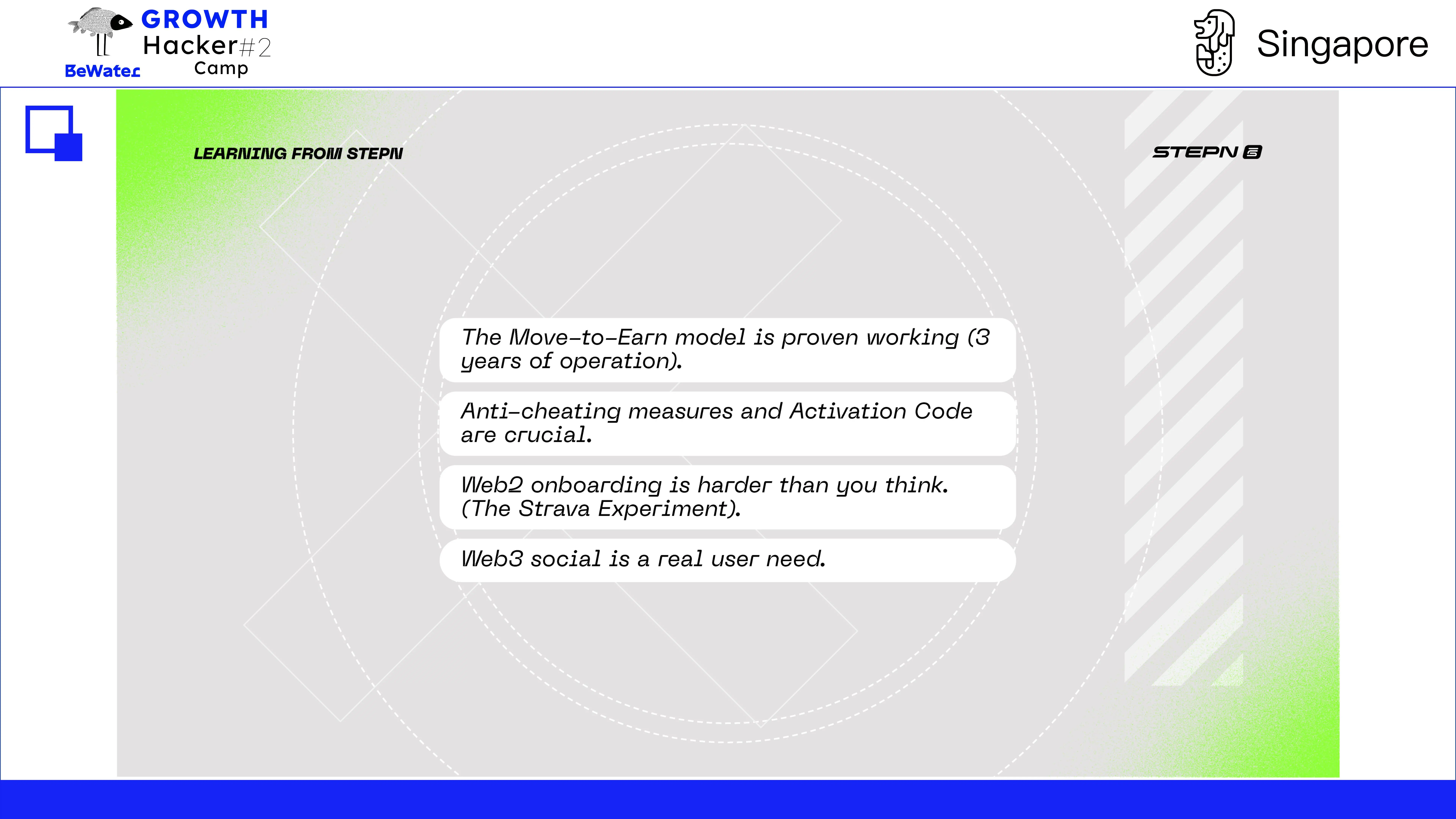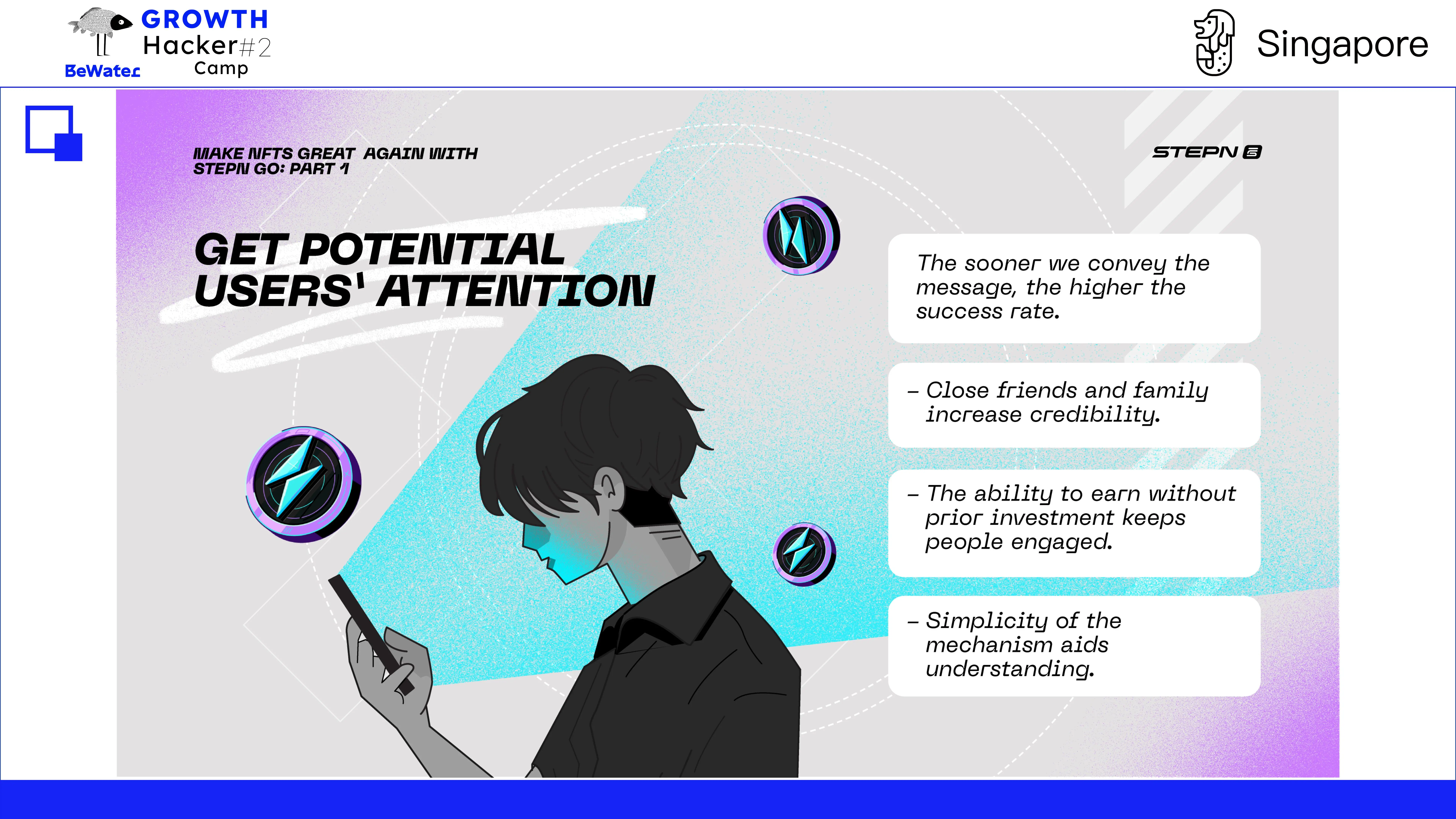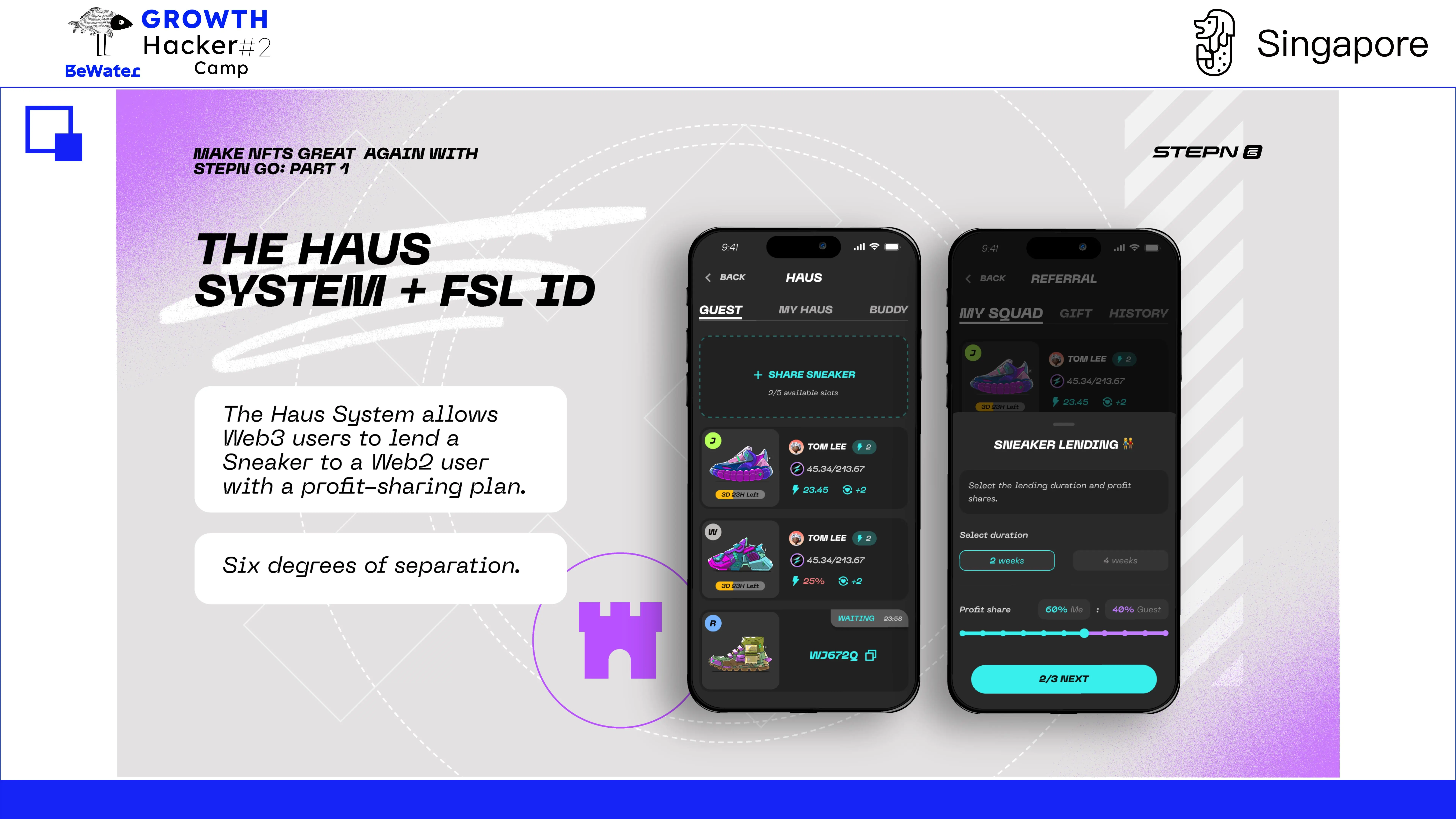Mentor: Yawn Rong, Co-Founder of StepN
Editor & Organizer: BeWater
Introduction: On September 21, the second session of the BeWater Growth Hacker Camp concluded successfully in Singapore. During this two-day event, mentors from top projects and VCs in the Web3 field deeply discussed core topics such as personal branding, growth strategies, community building, user retention, and conversion, providing valuable insights and inspiration to the attendees.
This growth training camp received high praise, and BeWater has compiled the content shared by the mentors into written form, establishing a "Growth" series for readers! The third article in this series is Yawn's "Make NFTs Great Again," here is a summary and extraction of Yawn's speech:
The current NFT market is at a critical juncture, facing numerous challenges, but NFTs remain an important bridge for traditional internet users to enter the Web3 world.
Why are NFTs no longer glorious?
NFTs can generally be divided into two categories: production NFTs (including GameFi) and collective NFTs (such as PFPs).
Production NFTs are experiencing a genuine "grow or die" dilemma. The demand for growth has led to unchecked issuance, causing market inflation, fluctuating values, and ultimately falling into a death spiral. The ecosystem of these production NFTs is overly fragmented, with projects disconnected from one another, making it difficult for users to grasp and engage deeply.
Collective NFTs create a closed circle culture due to their scarcity, making it hard for insiders to expand value outward, resulting in communities that at best have a few thousand people engaging in superficial celebrations. Meanwhile, spontaneous movements from outsiders, such as creating cultural shirts that feature "monkeys printed on $20 t-shirts," further diminish brand tone from another dimension. Brands are born from tone, and tone represents the community's attitude. The rampant copying reflects a lack of preventive mechanisms and a healthy environment. Additionally, the hype sustained by storytelling marketing lacks support from actual application scenarios, specifically how to transform "Situational Storytelling" into a "Sustainable Narrative." Ultimately, this can only be fleeting, leaving users with a sense of emptiness in their experience.
Why do we need to Make NFTs Great Again?
Essentially, compared to cryptocurrencies, the non-financial characteristics of NFTs can genuinely lower the psychological barrier for users. The criticized low liquidity actually leads users to categorize this asset as safer, making it easier to accept.
At the same time, NFTs allow for the conversion of Web3 assets between Tokens and NFTs, enhancing asset liquidity, and enabling project teams to design a series of activities around NFTs to increase community engagement and sense of belonging, forming an overlay of different gameplay on a flat surface. This user experience somewhat alleviates some of the inferiority complex Web3 has in front of Web2.
Most importantly, NFTs also possess unique social and emotional value, representing personal identity and interests in social networks, thus showcasing individual characteristics. This is a significant part of the digital lifestyle.


What experiences has StepN accumulated over the past three years?
- Validation of the Move-To-Earn model
After three years of operation, the Move-To-Earn model has been validated by the market. Annual returns, prices, and the stability of local communities (such as three offline events per month in Vietnam and Japan) and the non-financialization of the community prove the feasibility of this business model. Builders should pay attention to the potential of this model, especially in health and fitness applications.
- Importance of anti-cheating systems and activation codes
To ensure the sustainability of user growth, establishing effective anti-cheating systems and activation code mechanisms is crucial. In terms of anti-cheating, identifying witch attacks and bot attacks is particularly important. A lack of effective anti-cheating systems can severely impact user growth, damaging the project's credibility and development. Regarding activation codes, we must understand that consensus growth takes time; builders should master the rhythm of growth. We release 1.5% of activation codes daily, allowing only those who truly need, want, and will cherish our product's usage rights to participate. It is not all about a "high-profile" approach; sustainable growth is even more precious in Web3.
- Challenges in guiding Web2 users
Currently, it may be the most challenging time in Web3 history for user growth. Compared to Web2, guiding Web3 users is more complex. Users' acceptance and understanding of new technologies vary widely, and development teams need to invest more effort in education and guidance to improve user engagement and retention. It is especially important to make the transition for Web2 users into the Web3 space seamless and unnoticeable. Transforming the anti-human settings in Web3 into a user-friendly experience is essential for Web2 users to consider joining (and they may not even join). Here, we must adjust our mindset.
- The real demand for Web3 socializing
Web3 socializing is a necessity. Web3 users have spontaneously organized many social interactions. The rise of Web3 social platforms reflects users' demand for genuine social interactions. This trend indicates that projects should focus on building authentic and trustworthy social environments to enhance user stickiness and engagement. How to facilitate non-financial pairing between Web3 and Web2 users through socializing is a pressing issue.

How does StepN Go achieve sustainable growth?
How to capture user attention?
Scarcity of attention: User attention is the most valuable thing in contemporary times. In an age of information overload, user attention has become increasingly precious. Projects need to design content that attracts users to enhance participation.
Timeliness of information delivery: The earlier key information is conveyed, the higher the probability of success. Project teams should respond quickly to market changes and timely communicate important information to users.
Zero-investment incentive mechanisms: Allowing users to earn without upfront investment helps maintain user enthusiasm and attract more potential participants.
Simplifying mechanisms to enhance understanding: Complex mechanisms can confuse users; simplifying the user experience can effectively improve understanding and participation.

StepN Go rental system: The future of familiar socializing
The HAUS System and FSL ID are new mechanisms introduced by StepN. The HAUS system is a shoe rental system launched by StepN Go, allowing Web3 users to rent shoes to Web2 users through a revenue-sharing plan. FSL ID enables Web2 users to enter seamlessly via Email and FSL ID.
- Advantages of familiar socializing
The greatest advantage of familiar socializing lies in its depth and trust. Interacting with strangers often requires multiple screenings and verifications, while interactions among acquaintances are built on an existing foundation of trust. This trust makes information dissemination more efficient, and users are more likely to accept recommendations and opinions from friends.
- Six Degrees Theory and Influence
According to the Six Degrees Theory, a person can connect with anyone through a maximum of six introductions. This means that an individual's social network can expand rapidly as long as they can influence five friends or family members. Among each friend, at least one person is particularly interested in a specific field or activity, providing a foundation for the effectiveness of familiar social platforms.
- Potential of the rental system
Within the framework of familiar socializing, the introduction of a rental system will provide users with more opportunities. Users can obtain resources or experiences through rental services. This model not only meets users' needs but also promotes interaction and collaboration among them. Users are more willing to try these services through recommendations from acquaintances because they trust the recommender.
- Importance of real user experiences
To drive the success of familiar socializing, it is essential to start from the real experiences of users. Traditional social platforms often focus on user numbers and activity levels, but familiar socializing needs to pay attention to the genuine interactions and experiences between users. Platforms should focus on providing valuable content and activities rather than solely relying on test coins or virtual rewards. By creating authentic social scenarios, users will find it easier to engage and establish deep social connections.
The future of social networks will no longer be cold connections among strangers but warm interactions among acquaintances. By fully leveraging the advantages of familiar socializing, we can achieve a more efficient way of socializing and establish deeper trust relationships. With continuous optimization of user experiences and effective utilization of the rental system, familiar socializing will become the mainstream of future social interactions.

Sustainable growth
Consensus takes time; Bitcoin's consensus has taken over a decade. We need to allow growth to be slower. In addition to onboarding more Web2 users to curb inflation, we can also extend the product lifecycle, reshape the design of economic models, and eliminate Web2 thinking; at the same time, activation codes serve as an entry setting, ensuring slow but steady growth. Furthermore, improvements in mechanisms eliminate the greatest inflation—renewable resources.
With sustainable growth, people will feel secure, thereby promoting community development, achieving consensus, and driving consumption. This will boost demand for StepN Go's native Collective NFTs, positioning them as symbols of social status, further curbing inflation since Collective NFTs do not generate tokens.
Facing the End-Game: Strategies for Coping After Growth Stops
1. Understanding the Essence of the End-Game
The lifecycle of popular Telegram mini-games is very short; the "End-Game" does not signify the end of a project but rather a turning point. At this stage, projects need to reassess their market positioning, user needs, and competitive strategies. Understanding user consumption psychology and behavior during this phase is key; Web3 projects should focus on how to enhance user consumption experience and satisfaction.
2. Strategies to Promote User Consumption
To incentivize users to continue consuming, the following strategies can be adopted:
- Establishing Internal Consensus: First, projects need to build consensus within the community, clarifying goals and directions. Through the collective efforts of the team, a consistent marketing strategy and user experience can be formed. Internal unity will directly impact external user perceptions.
- Collaborating with Major Brands: Partnering with well-known brands can not only enhance the company's brand image but also attract more user attention. Through joint marketing activities, companies can leverage the influence of major brands to expand their market share. For example, launching co-branded products (like Adidas) or jointly hosting events to attract user participation.
- IP Collaboration: Purchasing or collaborating with well-known IPs is an effective strategy. This cross-industry collaboration can not only enhance brand visibility but also provide users with a unique consumption experience.
3. The Power of Social Sharing
In the End-Game phase, social sharing becomes an important means to promote user consumption. Users are willing to share their consumption experiences, especially when they believe a product or service has uniqueness or value. Projects can promote social sharing in the following ways:
- Show Off Mechanism: Encourage users to showcase their consumption results on social media. For example, launching user sharing activities where users can display their purchasing experiences, participate in a lottery, or receive discounts. This "showing off" behavior can not only enhance user engagement but also attract the attention of more potential users.
- Social Media Marketing: Utilize social media platforms for targeted marketing, publishing user-generated content (UGC) to enhance brand credibility and approachability. By interacting with users, projects can better understand user needs and adjust marketing strategies in a timely manner.
免责声明:本文章仅代表作者个人观点,不代表本平台的立场和观点。本文章仅供信息分享,不构成对任何人的任何投资建议。用户与作者之间的任何争议,与本平台无关。如网页中刊载的文章或图片涉及侵权,请提供相关的权利证明和身份证明发送邮件到support@aicoin.com,本平台相关工作人员将会进行核查。



